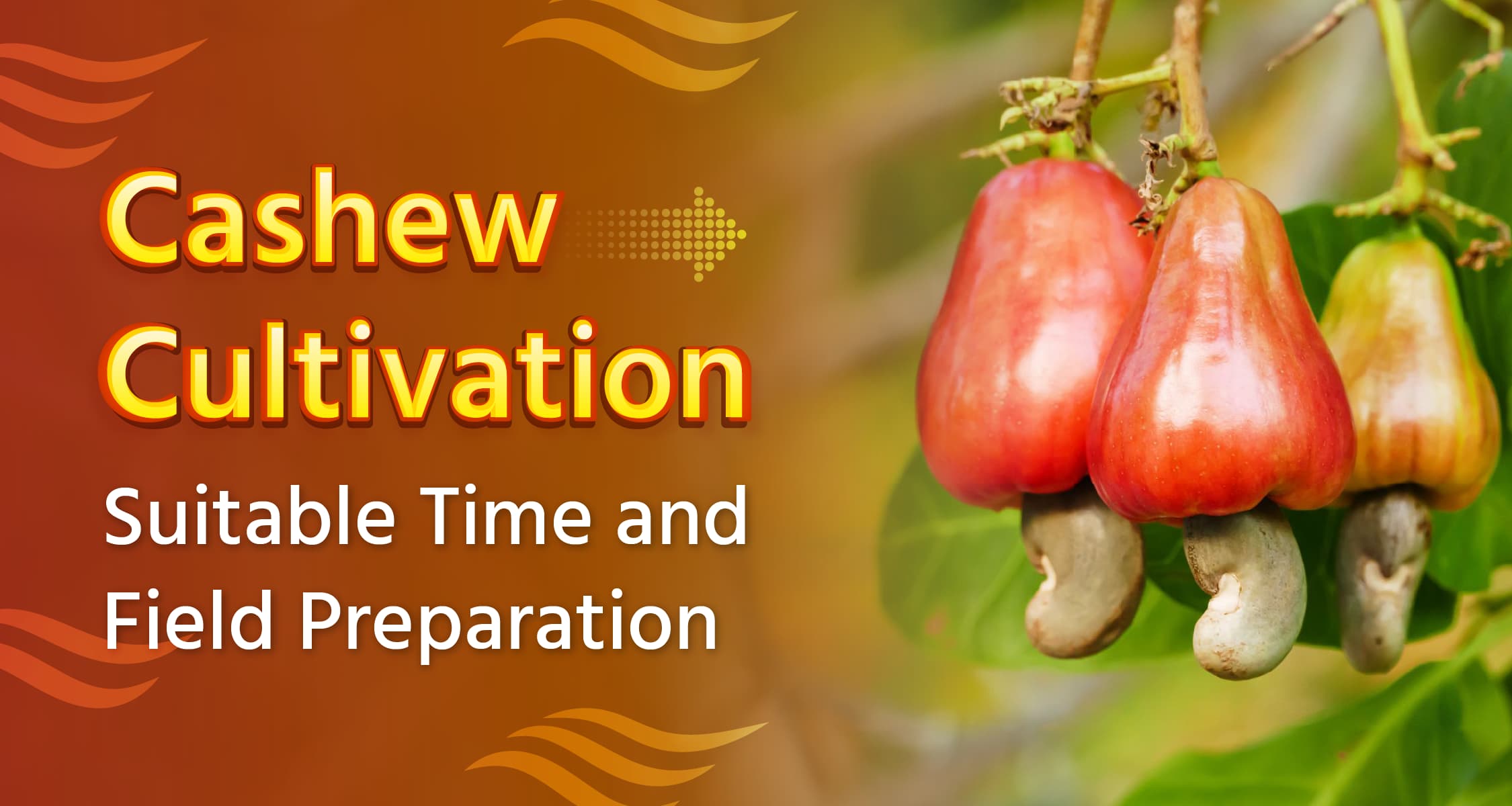Efficient Cultivation of Cashew: Suitable Soil, Varieties, Field Preparation

Cashew (काजू) is often considered the king of dry fruits. Its cultivation started first in India and it was planted for forest conservation. Cashew farming in India is done in Kerala, Karnataka, Tamil Nadu, Andhra Pradesh, Maharashtra, Goa, Odisha, West Bengal, Jharkhand, and Madhya Pradesh. Cashew is a major export crop and farmers can earn substantial profits from its cultivation.
How to Cultivate Cashew?
Climate
- A warm and tropical climate is considered optimal for cashew cultivation. Cashew is a tropical crop that thrives in regions where the temperature does not drop below 10°C in winter and remains between 32 to 36°C in summer. Cashew cultivation does not fare well in regions where there is prolonged cold or where temperatures fall below 20 to 35°C.
Suitable Soil
- Cashew cultivation can be easily done in various types of soils such as sandy, lateritic, and loamy soils. However, for higher yields, sandy soils with a coastal touch and lateritic soils are most suitable. Cashew crops can also be grown in barren and low-fertile soils. The pH of the soil should be between 5 to 6.5.
Efficient Varieties
- B.P.P.-1: Cultivation of this variety is mostly done in the eastern coastal regions. A single plant of this variety produces up to 15 kg of cashews every year. It has a shell of about 30% and a seed of about 5 gm. This variety provides yield for up to 25 years.
- B.P.P.-2: This variety of cashews is also grown in coastal areas. A single plant of this variety produces approximately 20 kg of cashews per year. It has a shell of about 26%. In addition to this, varieties 3, 4, 5, and 6 of BPP are found, which are grown in moderate temperatures and environments, and the yields of all varieties vary.
- Vengurla 1-8: This variety is cultivated on the western coastal shores. This variety of plant yields for about 30 years. From one plant of this variety, you can get 23 to 25 kg of cashews per year. It has up to 30% to 35% of the peel.
- Goa-1: This variety is grown in regions with western coastal shores. It yields approximately up to 25 kg of cashews per year. It has 25% to 30% of the peel.
- Additionally, varieties like VRI-1,2, Ullal-1,2, Anakkayam-1, Madakkathara-1,2, Dhana, Priyanka, Kanaka, BLA 39-4, K 22-1, and NDR 2-1, etc., are also cultivated.
Field Preparation
- Before sowing cashews, plow the fields 2-3 times and then level the field with a wooden plank.
- After that, prepare pits in the field which are 45 cm long, 45 cm deep, and 45 cm wide, then fill the pits with a mixture of cow dung manure, neem cake, and soil. Plant the seedlings at a distance of 5x4 meters, approximately 80 to 100 seedlings are required per acre.
- Leave the pits open for approximately 15-20 days, then mix 5 kg of cow dung manure or compost, and 2 kg of rock phosphate or DAP with soil. Spread the mixture over the pits.
- Ensure that water does not accumulate around the pits while making them.
Suitable Time and Method of Sowing
- Cashew plants are prepared using the softwood grafting method, and in some areas, plants are also prepared by stem. For higher yield and successful cultivation of cashews, their planting should be done between May and July, i.e., during the rainy season.
Irrigation
- Cashew is a crop entirely dependent on rainfall, but to achieve better yields, irrigation should be done according to the need from time to time. Irrigation is necessary for about two years after planting for the plant to develop well. Additionally, irrigation is done to prevent the fruits from falling when they are in the stage of formation.
Pruning
- Pruning should be done periodically for the proper development of cashew plants. Additionally, if any pests, diseases, or abnormalities are observed, infected parts should be pruned and removed.
Harvest and Yield
- Collect fallen nuts from the cashew tree, dry them in the sun, and store them in jute bags placed at a height. Each year, approximately every plant yields about 8 kg of nuts. Around 5-6 quintals of cashew nuts are obtained per acre.
What challenges do you face while cultivating cashews? Share your answers and experiences with us by commenting below. Follow the 'Krishi Gyan' channel now for more interesting and important information like this. And if you liked the post, don't forget to like it and share it with fellow farmers.
Frequently Asked Questions (FAQs)
Q: How many days does it take for a cashew tree to be ready?
A: Cashew trees are ready to bear fruit after 3 years of planting.
Q: Where is the cashew tree grown?
A: Cashew trees grow in tropical climates and thrive in well-drained soil and warm temperatures. Major cashew-producing countries include India, Vietnam, Nigeria, and Brazil.
Q: Which is the largest cashew-producing state in India?
A: According to the National Horticulture Board, farmers in Maharashtra produced 1,99,700 metric tons of cashews in 2021-22, which accounts for 25.82% of the total cashew production in India.
Please login to continue

Get free advice from a crop doctor
